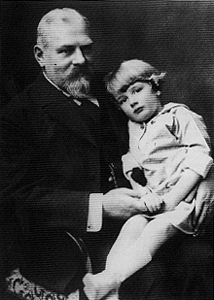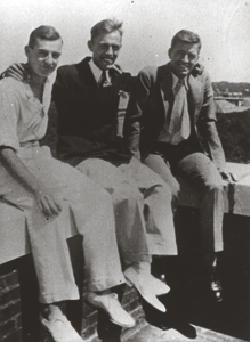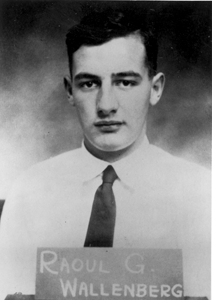” … You remember that before I came here, I argued that our institutions were better than American schools. But now I find that apart from the intended benefit, which was that I come to America to catch its spirit, I’ve also been getting a technical education that isn’t inferior to what I would have gotten in Sweden. I feel so at home in my little Ann Arbor that I’m beginning to sink down roots here and have a hard time imagining leaving it.” — A young Raoul Wallenberg, writing to his grandfather in Sweden during his years as an undergraduate student at U-M, 1931–35.
What if he hadn’t left?
What if Raoul Wallenberg had been selfish, thoughtless, superficial, and willing to ride out the atrocity known as World War II from “my little Ann Arbor”?
What if he had chosen to stay in America, apply his architectural and artistic talents here, make friends, raise a family, and grow old gracefully and comfortably?
But Raoul Wallenberg was not selfish or superficial. He did return to his native Sweden, and to a Europe where good people—especially victims of Nazi terror—had no guarantee of growing old gracefully or comfortably. They had no guarantee of growing old at all.
Be the change
It was that decision—a typical student’s desire to go home after graduation—that set into motion events that ultimately would lead Wallenberg to his greatest achievement—and to his mysterious demise. The Michigan graduate did not settle in Sweden for long, soon traveling to South Africa and then Palestine, where he worked with a Jewish banker from Holland. He bore early witness to the effects of the burgeoning Nazi movement as he encountered numerous Jews from German cities fleeing to Palestine, “reduced to ragged beggars by the Nuremberg laws,” according to Kati Marton in her book Wallenberg: Missing Hero.
By 1941 Wallenberg was traveling regularly to Budapest as an employee of the Central European Trading Company. Here he was deeply affected by the plight of increasingly desperate Jews under siege by the Nazi regime. The Hungarian Jewish population was the only one of any size left in 1944 Europe when President Franklin D. Roosevelt created the U.S. War Refugee Board (WRB) to help save victims of the Nazi and Axis powers. The WRB sought aid from a neutral Sweden—and Raoul Wallenberg, just 32 years old and already connected in Budapest, agreed to lead the Swedish effort.

One of Wallenberg’s counterfeit documents. (Image courtesy of the Wallenberg family.)
Few could have matched what he was able to do. Using his wits, charm, intelligence, and sheer bravery, Wallenberg outsmarted or faced down the Nazis whenever he could. At times, he just appeared in front of Nazi soldiers preparing to execute Jews, claiming their victims were Swedish citizens.
He created counterfeit Swedish passports and work permits that fooled authorities and allowed Jews to escape death. Then he housed many of these same people in 32 buildings that he claimed as Swedish territory, thereby verboten to the Nazis.
As the Soviet army marched toward Hungary at the end of the war, Wallenberg saved more than 70,000 Jews when Nazis surrounded their ghetto and prepared to execute them. He confronted the SS commander and asserted in no uncertain terms that he would be hanged for war crimes if the plans were carried out. The executions did not take place.
But even as he saved others’ lives, Wallenberg’s own days were numbered. On Jan. 17, 1945, soon after the Soviets had arrived in Budapest, Wallenberg was seen driving off with a Russian officer for a “meeting.”
He and his driver never were seen again.
A centennial celebration
A towering example of bravery, humanitarian commitment, self-sacrifice, and tragedy worthy of Shakespeare, Wallenberg is being heralded in a special way in 2012. The centennial of his birth is Aug. 4.
The Swedish government has created an exhibition, “To Me There’s No Other Choice,” which is traveling to major cities in Europe, North America, and Israel. The University of Michigan will host the exhibit Jan.31-Feb.28 in the Michigan Union. In addition, U-M’s A. Alfred Taubman College of Architecture and Urban Planning will host special commemorative activities this year.
John Godfrey, assistant dean at the Rackham Graduate School and chair of the Wallenberg Committee, hopes these events “will instill in the University’s memory Wallenberg’s uncommon courage in defense of humanity. Every Michigan student should know his name.” The centennial exhibit will include a section about Wallenberg’s life as a Michigan student.
The once and future hero
It is difficult to match Wallenberg’s idyllic youth in Sweden and Ann Arbor with his final years, so fraught with danger and intrigue. It is easy, however, to reconcile the young man people admired at Michigan and the hero who would save thousands of innocent lives.
Wallenberg was born to one of Sweden’s most prominent families—often referred to as the “Rockefellers of Scandinavia”—according to an extensive profile by Lilian E. Stafford, M.A. ’67/M.S. ’75, in the May 1985 Michigan Alumnus.

Wallenberg and his grandfather. (Image courtesy of the Wallenberg family.)
The Wallenberg family produced bankers, diplomats, bishops, and shipping and industrial executives. Wallenberg, expected to carry on such a distinguished tradition, grew up in comfort and happiness, although his father died just three months before Raoul was born. His grandfather, Ambassador Gustav Wallenberg, to whom Raoul’s letters from U-M are so tenderly and consistently addressed, filled in fully as his devoted father.
Wallenberg took part in a year of compulsory military training after high school. The choice of a university was hardly automatic to his grandfather who wished Raoul to study abroad and who, as Stafford wrote, “disliked the snobbery of the British upper classes and ruled out Oxford and Cambridge.” He apparently felt the same way about America’s Ivy League schools.
U-M, by contrast, “had an excellent reputation and a large number of its students came from families that could not afford the more prestigious eastern schools.” It was off to Ann Arbor for Wallenberg in 1931—in the midst of the Great Depression. His early and long interest in architecture led him to U-M’s then College of Architecture and Design, now the Taubman College.
Impressions of America
The young man portrayed later in books, magazine articles, and U-M publications is impossible not to like. In letters to his grandfather, who was Sweden’s attaché to Turkey at the time, Wallenberg emerges as fun-loving and adventurous, but also humble and hardworking; easy going, yet dedicated to his work.
In 1932 he wrote, “many of my friends have now joined these so-called fraternities, so I don’t see as much of them at meal times as I used to.” A former classmate later said Wallenberg declined to join a fraternity, though he could have afforded it, because it would isolate him from other, less prosperous students. “There was just no snobbery about him,” his classmate recalled.
Wallenberg also described to his grandfather how “getting in the paper is otherwise not particularly noteworthy here, because they print long stories about anybody and anything. If a few students go to a factory to flirt and pass their time, a couple of columns immediately appear about how a ‘student group investigated social conditions of the working class.'”
The adventurous young Wallenberg traveled across America and Canada, often hitchhiking with little money in his pocket. He reported on the economic hardships he saw and wrote of his fondness for American radio and classical music. His correspondence describes outings to Ann Arbor’s local pubs and his pride at joining a debating society in the College of Engineering and Architecture.
According to Stafford’s detailed profile, Wallenberg favored the informal American style. “He dressed in sneakers, ate hot dogs, and hitchhiked wherever he went … It is evident he was popular, energetic, and outgoing, endearing himself by his humor and unassuming ways.” Classmates nicknamed him Rudy and remembered him as gentle and intelligent.
One professor testified to Wallenberg’s courage: “He had no fear—that’s my impression of him … I can understand why he took the job in Budapest.”
A tragic and confounding mystery
So much has been said and written since Wallenberg disappeared in 1945. Books and films have chronicled his life and unexplained death. No definitive proof regarding the end of his life ever has emerged, though many speculate the Russians believed he was a spy and executed him.In the wake of unrelenting pressure by various governments and activists, the Soviets ultimately reported Wallenberg had been taken to Russia and died of a heart attack in 1947. But few accept this explanation; several former prisoners of the Russian gulags reported seeing and speaking with Wallenberg, or a Swedish man matching his general age and appearance, long after his supposed death.
By the mid-1960s the fascination with Wallenberg’s mysterious fate had faded from the public consciousness. But fresh interest came with new claims of Wallenberg encounters as late as 1987. Wallenberg supporters and admirers renewed their efforts to publicize his plight and learn the truth about his death. In 1998 California Congressman Tom Lantos, a Holocaust survivor rescued by Wallenberg, co-founded the International Raoul Wallenberg Foundation, an NGO devoted to preserving his legacy.
Honoring the ‘Righteous Gentile’
Today Wallenberg’s life and work is celebrated throughout the world. In 1981 the United States granted him honorary citizenship, a rare occurrence. Israel’s Yad Vashem, its memorial to Holocaust victims, recognizes him as the most outstanding of the “Righteous Gentiles.” Other monuments stand in London, Montreal, Budapest, Stockholm, and more. Schools and streets bear Wallenberg’s name. His image even appears on a U.S. postage stamp.
U-M’s Wallenberg Memorial (produced by art and design professor Jon Rush, who also designed the Wallenberg Medal) is a granite and stainless steel sculpture titled “Köszönöm Raoul Wallenberg” (or “Thank You Raoul Wallenberg”). The sculpture, dedicated in 1995, was a gift from Rush and the family of Sol King, Wallenberg’s classmate.
Since 1990 U-M has awarded the Wallenberg Medal to an outstanding humanitarian who embodies the medal’s inscription: “One Person Can Make a Difference.” In 2011 honoree Aung San Suu Kyi of Burma presented the Wallenberg Lecture via Skype from her home where she was under confinement. This year’s recipient is Maria Gunnoe, an advocate for environmental and social justice in her West Virginia mining community. Gunnoe is scheduled to deliver the 2012 Wallenberg Lecture on Oct. 23 at 7:30 p.m. in Rackham Auditorium.
In addition to organizing the annual Wallenberg Medal and Lecture, the Wallenberg Committee sponsors the Raoul Wallenberg International Summer Travel Fellowships. U-M students are selected to participate in community service or similar projects that exemplify Wallenberg’s spirit.
These are just some of the ways the University recognizes this exceptional alumnus, who finished his studies in three-and-a-half years and earned the American Institute of Architects silver medal for attaining the highest scholastic standing.
In happier times
One can only imagine what Wallenberg thought about during the possible decades of his captivity. Perhaps, now and then, he was cheered when he reflected back to those days in his “little Ann Arbor,” a place where he was carefree—learning, hitchhiking, laughing, and just being young and filled with hope.
How happy he was here, how simple was his life:
“I have spent this entire Christmas in Ann Arbor, as I had quite a lot to do,” he wrote to his grandfather in 1935. “However, I haven’t bored myself at all. We have been having fine weather, snow most of the time and a few days of quite severe cold. One morning something peculiar happened. Due to changes of temperature, I presume, the street pavements, lawns, and even tree trunks were coated with a layer of perfectly clear ice almost an inch thick. It looked very strange and very beautiful.”






Judy Landau - 1976
Wonderful makes me proud to have gone to Michigan
Reply
Robert Cope - '59, '61, '66
As a UM graduate, now living in Melbourne Australia, I was quite amazed seeing a monument to Wallenberg at an intersection, stopped, took some photos and wrote of his accomplishments. See him here if you like:
http://www.digitaljournal.com/article/323107
I am so happy to see this article too. Congratulations for keeping his spirit alive.
Reply
Steve Rauworth - 1970
An exemplary human being, worth emulating. Perhaps UM students and others will be inspired to action in changing the path the U.S., and Israel for that matter, are on. While more sophisticated about our methods of oppression, and not as overt and extreme, it’s a path that is not entirely dissimilar to the one of Nazi Germany.
Reply
Robert Lieberman - 1981
Check this out: http://www.facebook.com/events/376839655721110/
JustStories on Facebook presenting its 10th Festival. On Aug 1 from 10-11am, Syd Lieberman will be online to answer questions about his story “One Righteous Man” the story of Raoul Wallenberg.
Reply
Eszter Wilson - N/A
Thanks for the great article. My husband is an UM graduate and I am a Hungarian who heard a lot about Raul Wallenberg, know where he resided, knew a couple people who had worked with him. Therefore both my husband and myself appreciate this publication. Koszonom
Reply
Kathleen Sutter - 1965
My father met Raoul when he was an architecture student and I’m sure he was inspired by this exceptional human being. Raoul’s reasons for choosing the school in his “little Ann Arbor” and his letters to his grandfather echo my sentiments exactly. I’m so proud to have attended a university with a conscience.
Reply
Kirk Nims
I had the pleasure of learning of Raoul Wallenberg from his girlfriend (or probably one of them) from the time that they were both studying here in Ann Arbor. She spoke of him fondly and of his bravery demonstrated through his actions in saving the people that he saved. Both she and Raoul (through her) were amazing people whom I feel grateful to have known.
Reply
Carla Smith
Kirk: Would you let me know either way if Raoul’s girlfriend that you are referring to might have been Berniece Ringman? She was my great aunt and godmother. I have fond memories of her and would love to learn more about her. Thanks, Carla Smith
Reply
Barry Waldman - 1989
What an amazing person. I knew of his good deeds and ties our university, but so nice to hear more about his early life. Shows that anyone can make a difference.
Reply
Jon Rush - Emeritus Faculty
The U.M. Memorial to Raoul Wallenberg is located at the west entrance of the Art and Architecture Building on the N. Campus. To view the memorial, just Google : KOSZONOM RAOUL WALLENBERG
Reply
Anders Andersson
We all make choices in our lives. Only a few of these choices might lead to extraordinary outcomes for people. Few people will follow through on made choices. Raoul did not only make extraordinary choices but he knew which ones to make and follow through on, delivering endless opportunities and life for people.
Reply